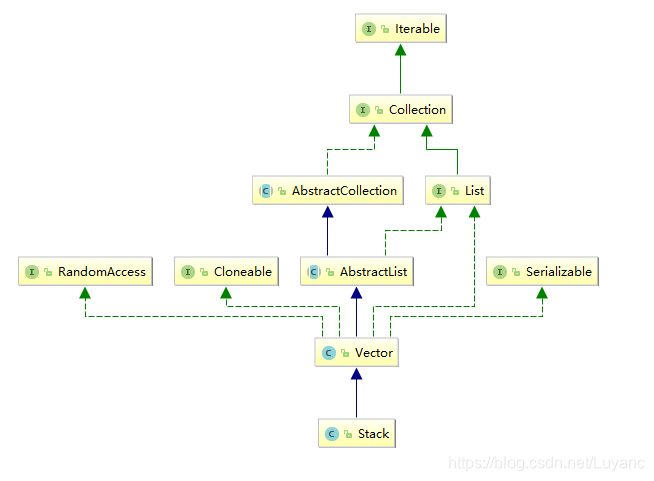再来稍微聊一下Vector的特点。
| 继承树 |
Vector继承树如下图:

| 特点 |
(1)允许null值
(2)底层使用动态对象数组Object[] elementData
(3)默认初始容量是10,也可通过构造函数指定初始容量(实际分配值)
(4)线程安全,通过synchronized锁得以保证
(5)fail-fast机制
(6)扩容与capacityIncrement参数相关,若此参数大于0,则按该值扩增容量,否则,成倍扩增
(7)如果需要扩容,则先扩容,再插入元素。
| 扩容机制---源码分析 |
以addElement方法为例:
/**
* Adds the specified component to the end of this vector,
* increasing its size by one. The capacity of this vector is
* increased if its size becomes greater than its capacity.
*
* <p>This method is identical in functionality to the
* {@link #add(Object) add(E)}
* method (which is part of the {@link List} interface).
*
* @param obj the component to be added
*/
public synchronized void addElement(E obj) {
modCount++;
ensureCapacityHelper(elementCount + 1);
elementData[elementCount++] = obj;
}
/**
* This implements the unsynchronized semantics of ensureCapacity.
* Synchronized methods in this class can internally call this
* method for ensuring capacity without incurring the cost of an
* extra synchronization.
*
* @see #ensureCapacity(int)
*/
private void ensureCapacityHelper(int minCapacity) {
//容量保证,数组容量满了之后才会触发扩容
// overflow-conscious code
if (minCapacity - elementData.length > 0)
grow(minCapacity);
}
再看扩容方法的核心:
/**
* The maximum size of array to allocate.
* Some VMs reserve some header words in an array.
* Attempts to allocate larger arrays may result in
* OutOfMemoryError: Requested array size exceeds VM limit
*/
private static final int MAX_ARRAY_SIZE = Integer.MAX_VALUE - 8;
private void grow(int minCapacity) {
// overflow-conscious code
int oldCapacity = elementData.length;
//根据capacityIncrement参数值决定扩容容量:指定值扩容/成倍扩容
int newCapacity = oldCapacity + ((capacityIncrement > 0) ?
capacityIncrement : oldCapacity);
//要确保扩容值不能小于最小扩容容量
if (newCapacity - minCapacity < 0)
newCapacity = minCapacity;
//保证扩容值不会超过数组最大容量
if (newCapacity - MAX_ARRAY_SIZE > 0)
newCapacity = hugeCapacity(minCapacity);
elementData = Arrays.copyOf(elementData, newCapacity);
}
private static int hugeCapacity(int minCapacity) {
if (minCapacity < 0) // overflow
throw new OutOfMemoryError();
return (minCapacity > MAX_ARRAY_SIZE) ?
Integer.MAX_VALUE :
MAX_ARRAY_SIZE;
}
| 关于Stack |
Stack的继承树:

Stack继承了Vector,也是线程安全的,方法上使用了synchronized锁。正如它的名字,它是一种先进后出的栈结构。





















 201
201











 被折叠的 条评论
为什么被折叠?
被折叠的 条评论
为什么被折叠?








